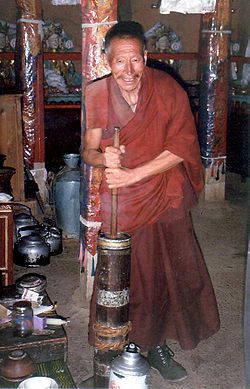
Butter tea
Encyclopedia

Chinese language
The Chinese language is a language or language family consisting of varieties which are mutually intelligible to varying degrees. Originally the indigenous languages spoken by the Han Chinese in China, it forms one of the branches of Sino-Tibetan family of languages...
: sūyóu chá (酥油茶) or goor goor in local Ladakh
Ladakh
Ladakh is a region of Jammu and Kashmir, the northernmost state of the Republic of India. It lies between the Kunlun mountain range in the north and the main Great Himalayas to the south, inhabited by people of Indo-Aryan and Tibetan descent...
i terms, is a drink of the Tibetans and Chinese minorities in southwestern China. It is also consumed in Bhutan
Bhutan
Bhutan , officially the Kingdom of Bhutan, is a landlocked state in South Asia, located at the eastern end of the Himalayas and bordered to the south, east and west by the Republic of India and to the north by the People's Republic of China...
. It is made from tea
Tea
Tea is an aromatic beverage prepared by adding cured leaves of the Camellia sinensis plant to hot water. The term also refers to the plant itself. After water, tea is the most widely consumed beverage in the world...
leaves, yak butter
Yak butter
Yak butter is butter made from the milk of the domesticated yak . It is a staple food item and trade item for herding communities in south Central Asia and the Tibetan Plateau...
, and salt
Salt
In chemistry, salts are ionic compounds that result from the neutralization reaction of an acid and a base. They are composed of cations and anions so that the product is electrically neutral...
.
Usage
Drinking butter tea is a regular part of Tibetan life. Before work, a Tibetan will typically down several bowlfuls of this beverage, and it is always served to guests. Nomads are said to often drink up to 40 cups of it a day. Since butter is the main ingredient, butter tea is a very warming drink, providing lots of caloric energy and is particularly suited to high altitudes. The butter also helps prevent chapped lipsChapped lips
Chapped lips or Cracked lips is a condition whereby the lips become dry and possibly cracked. It may be caused by the evaporation of moisture. Often the lips become dry because the layer of oil that is naturally produced by the body to coat the lips is removed or is lacking...
.
According to the Tibetan custom, butter tea is drunk in separate sips, and after each sip the host refills the bowl to the brim. Thus, the guest never drains his bowl; rather, it is constantly topped up. If the visitor does not wish to drink, the best thing to do is leave the tea untouched until the time comes to leave and then drain the bowl. In this way etiquette is observed and the host will not be offended.
Butter tea is also used for eating tsampa
Tsampa
Tsampa is a Tibetan staple foodstuff, particularly prominent in the central part of the region. It is roasted flour, usually barley flour and sometimes also wheat flour or rice flour...
by pouring onto it, or dipping the tsampa into it, and mixing well.
The concentrate, produced by repeatedly boiling tea leaves, will keep for several days, and is commonly used in towns. The tea is then combined with salt and butter in a special tea churn , and churned vigorously before serving hot. Nowadays an electric blender
Blender
A blender is a kitchen appliance for chopping or liquefying food.Blender may also refer to:Media:* Blender , a music-themed magazine* Blender , a free and open-source software program for 3D modeling, animation, and rendering...
is often used.
History

Dalai Lama
The Dalai Lama is a high lama in the Gelug or "Yellow Hat" branch of Tibetan Buddhism. The name is a combination of the Mongolian word далай meaning "Ocean" and the Tibetan word bla-ma meaning "teacher"...
, tea had become a government monopoly. While it is now officially allowed to be sold by anyone, it still is mostly sold by government officials.
Preparation
The highest quality tea is made by boiling the tea leaves in water for half a day, achieving a dark brown color. It is then skimmed, and poured into a cylinder with fresh yak butter and salt which is then shaken. The result is a purplish liquid that is about the thickness of a stew or thick oil. It is then poured into clay tea-pots, or jars, that resemble Japanese teapots.Another method is to boil water, and add handfuls of the tea into the water, which is allowed to steep until it turns almost black. Salt is then added, along with a little soda if wanted. The tea is then strained through a horse-hair or reed colander into a wooden butter churn, and a large lump of butter is added. This is then churned until the tea reaches the proper consistency and transferred to copper pots that sit on a brazier to keep them warm. When a churn is not available, a wooden bowl and rapid stirring will suffice.

